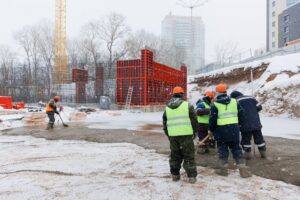Introduction
Winter brings to mind a picturesque landscape blanketed in snow, but for workers, it also poses unique challenges to safety. The cold temperatures, icy surfaces, and unpredictable weather conditions demand heightened vigilance to ensure the well-being of both workers and the projects they undertake. In this comprehensive guide, we’ll delve into the critical aspects of worker safety during the winter season, offering insights, tips, and best practices to navigate the winter season safely and successfully.
1. Understanding the winter risks
Winter introduces a host of risks that can impact worker safety. Slippery surfaces, reduced visibility, and exposure to cold temperatures are just a few examples. Recognizing these risks is the first step in developing an effective winter safety strategy.
2. Personal protective equipment (PPE)
Proper PPE is the frontline defense against winter-related risks. Insulated gloves protect hands from the biting cold, while waterproof and slip-resistant footwear prevents falls. Thermal clothing ensures workers stay warm without compromising mobility. Adequate PPE not only safeguards against environmental conditions but also promotes comfort, allowing workers to focus on their tasks without anything limiting their capabilities.
3. Slip and fall prevention
Slips and falls are common but preventable winter incidents. The right footwear, such as shoes with proper traction or ice cleats, significantly reduces the risk. De-icing measures, including salt or sand applications, help maintain safe walkways. Snow removal plans, conducted promptly and efficiently, contribute to a safer working environment. Educating workers about the importance of cautious movement on icy surfaces further enhances prevention. As it is one of the leading causes of workplace incidents in the winter, EHS managers should pay extra attention to ensure they’ve implemented an effective framework to bring down the probability of risk to a minimum.
4. Cold stress awareness
Understanding cold stress and its effects is vital for safeguarding workers’ health. Cold stress occurs when the body loses heat faster than it can produce, leading to conditions like hypothermia or frostbite. While this issue arises more commonly in areas with exceptionally harsh winters, it’s worth noting for everyone. Workers should be educated in recognizing symptoms, such as shivering or numbness, and encouraged to take breaks in warm areas. Proper acclimatization, allowing the body to adapt to colder conditions gradually, is essential.
5. Winter-specific training
Implementing comprehensive training programs specifically tailored to winter conditions equips workers with the knowledge to navigate the unique challenges of the season. Emergency response procedures specific to winter incidents, hazard recognition in snow-covered environments, and the correct use of winter equipment, such as snow blowers or de-icing tools, are crucial components. Winter-specific training fosters a proactive and prepared workforce and should be implemented well in advance of the colder months approaching.
6. Vehicle safety in winter conditions
For workers relying on vehicles, winter driving poses distinct challenges. Black ice, reduced visibility, and slower response times require special precautions. Winterizing vehicles involves checking brakes, tires, and fluids. Safe driving practices, such as maintaining a safe following distance and avoiding abrupt maneuvers, are emphasized. Regular vehicle maintenance ensures reliability in harsh conditions. Workers should be educated on these measures to ensure vehicle safety during the winter months.
7. Site-specific considerations
Different worksites face different winter challenges. As a safety professional, it is your duty to identify and address site-specific considerations, such as the impact of snow accumulation on structures, the importance of proper drainage, and strategies for managing winter-specific hazards on your sites.
8. Communication and emergency preparedness
Effective communication is always crucial during operations, and winter is no different. Ensuring that workers are aware of weather forecasts, emergency procedures, and communication protocols can enhance overall safety. Ensure that your safety program addresses the significance of communication and emergency preparedness during the winter season.
9. Monitoring and adaptability
Winter conditions can change rapidly. Implementing a robust monitoring system and fostering adaptability among workers are key components of a successful winter safety strategy. The strategy should include real-time monitoring, regular safety briefings, and the ability to adjust plans based on evolving weather conditions.
10. Integrating external workers
If your organization regularly hires external contractors to complete projects, an effective contractor management program is required to seamlessly integrate external workers in your wider winter safety strategy. In many cases, the workers you onboard may be unfamiliar with your safety practices, so it is vital that you have a framework that can bring them up to speed for them to contribute to the safety of your workplace, especially during the winter months in which workers find themselves encountering unique challenges.
Closing remarks
As winter approaches, workers must navigate the challenges it brings with a keen focus on safety. By understanding the unique risks, implementing targeted safety measures, and fostering a culture of awareness, workers can ensure a safe and successful winter season. This guide serves as a roadmap for workers and EHS professionals, empowering them to overcome harsh winters and carry out their projects with confidence even in the coldest months of the year.
Addison Moore is Director of Marketing at Contractor Compliance.

